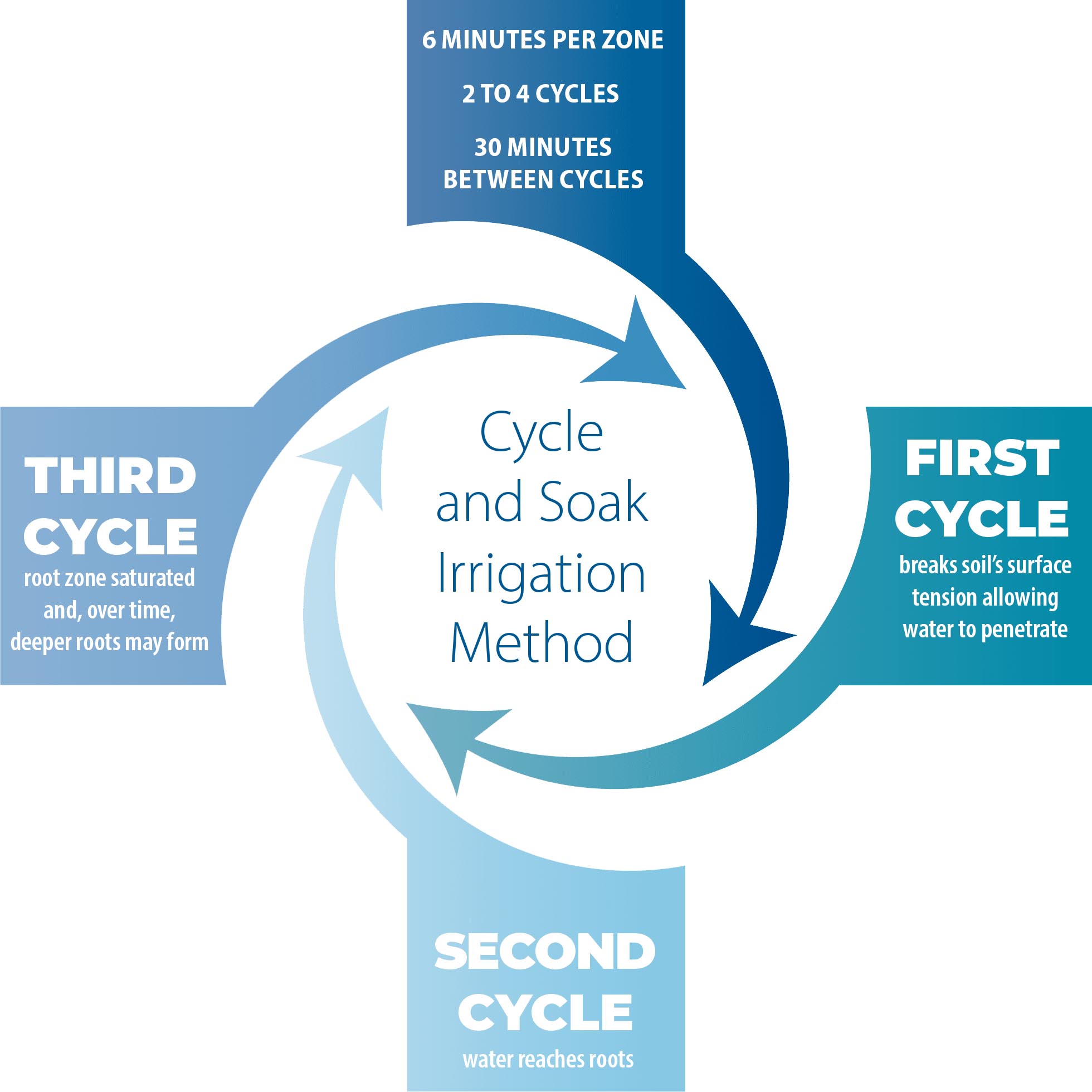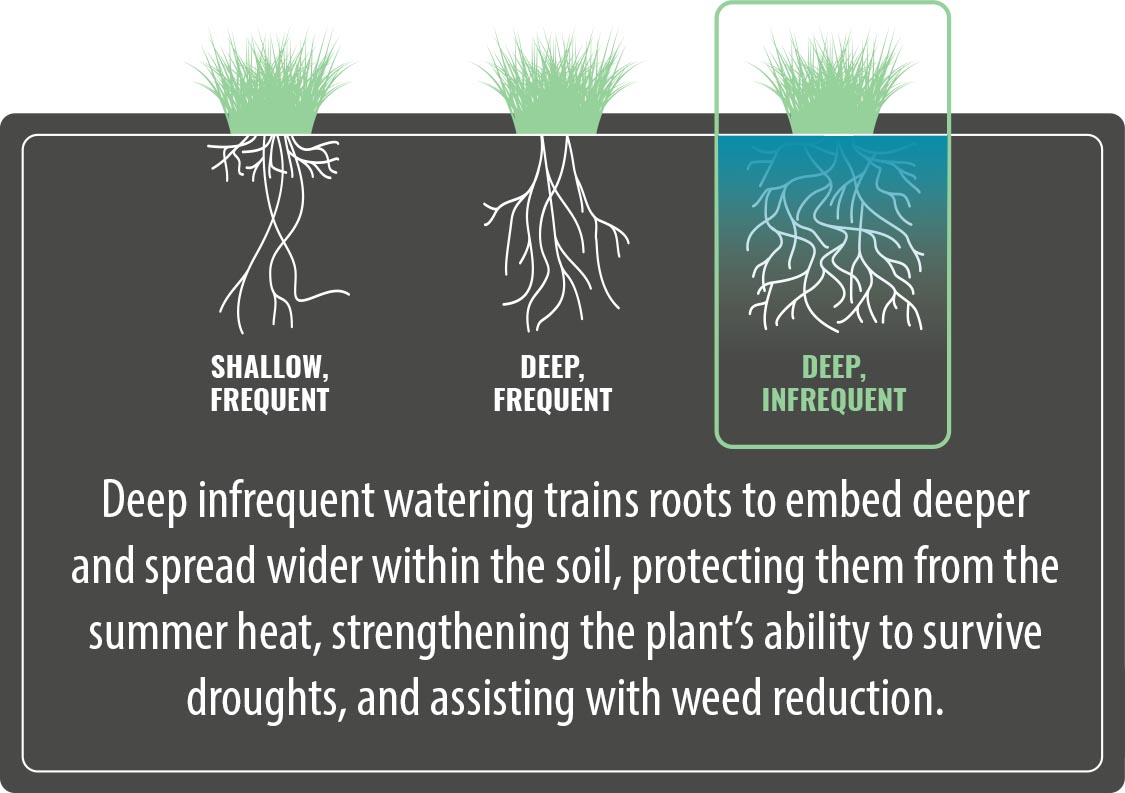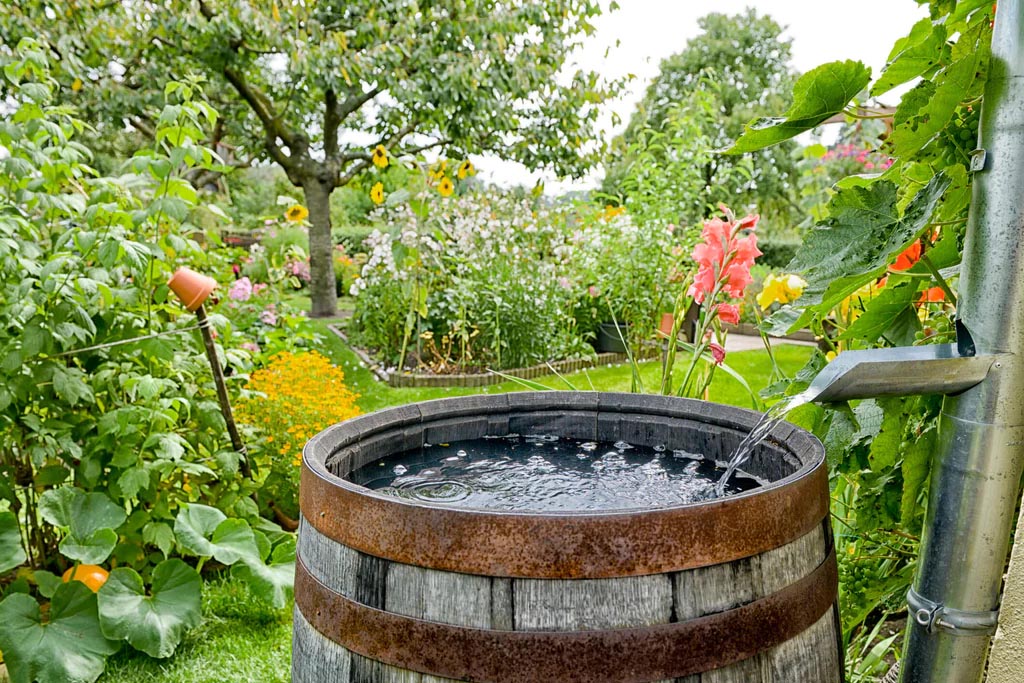T
Irrigation Regulations
Regulations within the Town of Pantego's Water Management Plan (adopted via Ordinance 2011-625) apply to all locations — regardless of zoning — and are enforced by a system of warnings followed by fines for unaddressed or otherwise repeated violations.
- The use of sprinklers (whether they be underground systems or faucet-run hose attachments) for irrigation is prohibited from 10:00 a.m. to 6:00 p.m. every day. Hand watering with hoses, soaker hoses, or dispensers is allowed at any time except when precipitation is falling. All manner of outdoor watering is prohibited during any form of precipitation.
- New irrigation systems must include rain and freeze sensors and retrofitting of existing irrigation systems with these features is highly encouraged. These features can help to save on your water bill and ensure that your system is not running during the rain, which could result in a warning or fine.
- The utilization of a poorly maintained irrigation system that wastes water by leaking or spraying directly onto impervious surfaces or onto other non-irrigated areas is prohibited. Adjust your sprinkler heads to ensure they are not spraying onto hard surfaces like driveways, sidewalks, parking lots, patios, fencing, the street, or other impervious surfaces. Repair broken or cracked heads to prevent excess water use.
Watering during the heat of the day can result in more than half of irrigation being lost to evaporation. Watering during the early morning hours is optimal as it minimizes evaporation and is less likely than late-night watering to allow for fungal growth. Do your part to conserve our most valuable natural resource by implementing rainwater harvesting, cycle and soak irrigation, and Texas SmartScape™ practices.

Optimize Your Irrigation System
The average American family uses 320 gallons of water per day, about 30 percent of which is devoted to outdoor uses. Nationwide, this adds up to nearly 9 billion gallons per day. It is estimated that as much as 50 percent of water used for irrigation is wasted due to evaporation, wind, or runoff. Simple changes can save water and money:
- Program your controller to take advantage of features like rain skips
- Don’t water between 10:00 a.m. and 6:00 p.m. when more water will evaporate
- Adjust sprinklers to only spray landscaped areas and not on concrete, fencing, or walls
- Decrease or stop watering when grass is dormant during cooler months
- Adjust for changing rainfall and temperatures
- Use the cycle and soak method (more information below)
- Evaluate and repair your sprinkler heads regularly
Are you following all of the regulations in the Town of Pantego's Water Management Plan? If not, you could be fined.

Cycle and Soak Irrigation Method
Clay-based soils often found in our region have a much slower absorption rate. Water applied past the first six minutes of a cycle usually becomes runoff. The cycle and soak method recommends running sprinkler zones for about five minutes each and then allowing about thirty minutes for the water to absorb into the ground before cycling again. Not only can this method help you to get the most value from the water used on your lawn, but it also encourages plants to grow deeper roots, increasing hardiness.
Not sure how many cycles to run? About an hour after watering, push a long screwdriver into the soil. An area has been adequately watered if the probe easily slides to a depth of 6 to 8 inches. Scroll down to view plants that do well in Pantego or download our Gardener's Guide (PDF).

Recommended Plants
Trees
- Austrian Pine (sun)
- Bald Cypress (sun)
- Black Japanese Pine (sun)
- Crepe Myrtle (sun)
- Desert Willow (sun)
- East Texas Palatka (sun)
- Elms – Weeping Willow (sun)
- Fig (am sun, pm shade)
- Forest Pansy Redbud (shade)
- Mesquite (sun)
- Mimosa (am sun, pm shade)
- Mondell Pine (sun)
- Oaks (sun)
- Oklahoma Redbud (shade)
- Pecan (sun)
- Wax Myrtle (sun or shade)
- Yaupon Holly (sun or shade)
Vines and Ground Cover
- Asian Jasmine (sun or shade)
- Boston Ivy (sun or shade)
- Carolina Jasmine (sun)
- Chinese Wisteria (shade)
- Cypress Vine (sun)
- English Ivy (shade)
- Honeysuckle (sun or shade)
- Trumpet Vine (sun)
- Virginia Creeper (partial sun)
Annuals
- Bougainvillea (sun or shade)
- Carpet Periwinkle (sun)
- Germander (am sun)
- Moss Rose (sun)
- Penta (am sun, pm shade)
- Periwinkle (sun)
- Petunias (sun)
- Snapdragons (sun)
Shrubs
- Antique Rose (sun)
- Arborvitae (sun)
- Aucuba (shade)
- Buddleia (am sun, pm shade)
- Burford Holly (sun or shade)
- Camellia (shade)
- Cherry Laurel (shade)
- Cleyera (shade)
- Cotoneaster (sun)
- Elea gnus (sun or shade)
- Euonymus (sun or shade)
- Firebush (shade)
- Forsythia (shade)
- Foster Holly (sun or shade)
- Gardenia (shade)
- Hardy Hibiscus (sun)
- Holly Fern (shade)
- Horse Tail Reed (shade)
- Indian Hawthorn (sun or shade)
- Junipers (sun)
- Ligustrum (sun or shade)
- Nandina (sun or shade)
- Oleander (sun)
- Photinia (sun)
- Pigeonberry (shade)
- Pittosporum (partial sun)
- Privet (sun)
- Pyracantha (sun)
- Quince (sun)
- Sumac (sun)
- Tropical Hibiscus (partial sun)
- Turk’s Cap (shade)
- Umbrella Sedge (shade)
- Yaupon Holly (sun or shade)
- Yucca (sun)
Perennials
- Anisacanthus (sun)
- Artemisia (sun)
- Blackfoot Daisy (sun)
- Blue Shade Ruellia
- Cactus (sun)
- Cape Cod Plumbago
- Coralberry (shade)
- Coreopsis (sun)
- Dahlia (partial sun)
- Datura (partial sun)
- Daylilies (partial sun)
- Dianthus (sun)
- Gayfeather (sun)
- Gazania Daisy (sun)
- Germander (am sun)
- Green Santolina (sun)
- Homestead Verbena
- Lamuim (shade)
- Lantana (sun)
- Mexican Bush Sage
- Mexican Heather
- Mexican Petunias
- Pink Panda (shade)
- Salvia (partial sun)
- Salvia Greggii
- Sedum (sun)
- Verbena Bonariensis
- Veronica (partial sun)
- Wood Violets (shade)
- Yarrow (partial sun)
Herbs
- Basil (partial sun)
- Chives (sun or shade)
- Lemon Thyme (sun)
- Oregano (partial sun)
- Rosemary (sun)
- Rue (sun or shade)
Salt-Intolerant (Not Recommended) Plants
- Abelia
- Ajuga
- Azalea
- Boxwood
- Chinese Holly
- Common Verbena
- Coneflower
- Hybrid Roses
- Hydrangea
- Japanese Maple
- Lavender
- Lavender-Cotton
- Magnolia
- Maple Trees
- Monkey Grass
- Thyme
Wood Fern

Rainwater Harvesting
North American tap water has, on average, 18 to 41 mg of salts per liter. Because salinity levels are higher in this portion of the state and because the region has quite a lot of clay soils, which hold salt better, gardeners should aim to use rainwater whenever possible and choose those plants that are more resistant to salt. Rainwater harvesting and the use of more salt-tolerant plants are two methods to becoming a successful gardener in Pantego. Scroll down to view plants that do well in Pantego or download our Gardener's Guide (PDF).
Rainwater harvesting is an innovative approach to capturing free water that is free of salts and other minerals that can harm root growth. As rainwater percolates into the soil, it forces salts down and away from root zones, allowing roots to grow better and making plants more drought-tolerant. A house with a 1,000-square-foot roof could "harvest" 600 gallons of rainwater from a one-inch rainfall.
By capturing, diverting, and storing rainwater for later use in the home landscape saves you money by reducing your water bills, reduces demand on the municipal water supply, makes efficient use of a valuable resource, and reduces flooding, erosion, and contamination of surface water with sediments, fertilizers and pesticides in rainfall run-off.
Helpful Links




